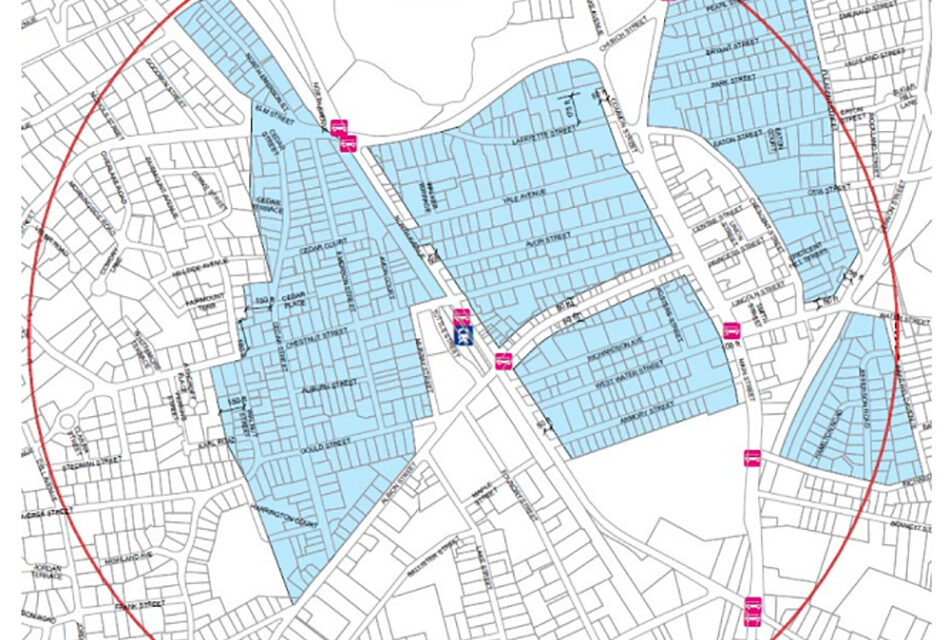By MARK SARDELLA
WAKEFIELD — At a public forum last week, the Planning Board heard more criticism of a local zoning plan devised to meet a new state requirement for a multi-family housing district near public transportation.
The public feedback received last week mirrored that of a similar forum held in October, when residents questioned why Wakefield’s plan goes well beyond the state requirements both in terms of the geographic size and the number of multi-family housing units allowed.
Planning Board member Jim Hogan, who also chairs the “Working Group” that created the plan, began last week’s session with an overview of the new state mandate.
In 2020, the Massachusetts Zoning Act (Section 3A of Massachusetts General Laws Chapter 40A) was amended to promote the production of multi-family housing within walking distance of public transportation to address a “severe regional housing shortage.” The state claims that there is a shortage of up to 200,000 housing units.
“Multi-family housing near transit creates walkable neighborhoods with climate and transportation benefits,” according to the Executive Office of Housing and Livable Communities, “including better access to work/services, increased utilization of public transit and reduced reliance on single-occupancy vehicles.”
The new Zoning Act requires all MBTA communities, including Wakefield, to create at least one zoning district of reasonable size near public transit in which multi-family housing is permitted as of right. “As of right” means that a developer may proceed without obtaining a Special Permit, variance, zoning amendment, waiver, or other zoning approval.
In the proposed district, the plan would allow up to four units in a three-story building with a height of up to 35 feet on a minimum lot size of 4,000 square feet.
MBTA communities have until Dec. 31, 2024 to create such a by-right multifamily zoning district. Communities that do not comply would be ineligible for certain state grants and other funding sources from the Commonwealth.
But the compliance plan devised by Wakefield’s “MBTA Communities Working Group” was criticized at last week’s public forum for allowing even more new multifamily housing density than what is required by the state. The Working Group is recommending a plan that goes well beyond the minimum requirements, encompassing neighborhoods not just around the train station, but east of Main Street.
For Wakefield, the minimum size required for this new multi-family zoning district would be 114 acres, but the Working Group is proposing a multi-family zoning district of 145.5 acres – far exceeding state requirements. The Working Group’s plan would also allow 2,355 additional housing units to be created in the district, even though the state only requires 1,696 units.
Residents questioned why a larger than required multi-family zone was being recommended.
Brendan LaRoche of Dellano Lane said that the proposed district was too large, adding that allowing more multi-family housing than required will reduce the stock of single-family homes as developers convert them to multi-family dwellings. That shortage will increase the price of remaining single-family homes, he argued.
Bronwyn Della-Volpe said that she objected to the town being “held hostage” by this new legislation. She also expressed concern over parking, insisting that people will not give up their cars just because they live near public transit.
Della-Volpe also questioned the claim that the state has a shortage of 200,000 housing units. “Where are all those people living now?” she wondered.
Wakefield Economic Development Director Erin Kokinda responded by stating that people and businesses are leaving the state due to the housing shortage. She also asserted that single-family homes have more cars than multi-family homes.
Dawn Millward of Emerald Street questioned whether the Working Group is really listening to what the public is saying.
“We are done with the big buildings,” she said. “We are done with the traffic. Traffic in Wakefield is at an all-time high,” she insisted, making driving kids to school in the morning “a nightmare.”
Things got a little tense when Planning Board member Bill Spaulding interrupted Millward, claiming that she was straying from the topic.
Millward reiterated that the residents of the town do not want a compliance plan that creates more density than necessary.
“Doing what is required by the state is fine and dandy,” she said. “I don’t think the townspeople want more than what is needed.”
Becky Wilson of Yale Avenue observed that many of the town’s historic properties fall within the proposed district. She expressed concerns related to retaining the historic character of those neighborhoods under the proposed plan.
Jim Sullivan of Harwick Road also questioned why the working group was proposing a plan that includes a larger multi-family district than required.
Hogan explained that the working group believed that allowing four units as of right was “not materially different” from what exists now in those neighborhoods. He said that the working group felt that “If we’re going to do rezoning, we might as well deliver a little bit of additional housing stock.”
Sullivan also questioned the plan’s ability to deliver the amount of off-street parking that would be needed. He said that he “completely disagreed” with making the district any bigger than it has to be, calling it an “unfunded mandate” from the state.
Joe Tavano of Eaton Street said that he envisioned a lot of single-family homes getting bulldozed by developers as they buy up properties to create 4-family homes.
“This will decrease rentals, decrease ownership and result in fewer single-family homes,” he said. He also addressed the state funding that would be withheld from towns that don’t comply.
“It doesn’t seem like a lot of money to be held hostage for,” he said.
Dave Bonner of Cumberland Road had a different view. He said he was “appalled” by what he was hearing from opponents of the plan, particularly the notion that “people are rushing in to steal our town.”
Planning Board member Matthew Lowry addressed those objecting to the plan as too large.
“I keep hearing that people want to do the minimum,” he said. “We could bring this district way down but would have to increase the unit count. We made a decision to spread it out more and keep the unit count down. If you want a small district, you’re going to have some big buildings.”
Andrew Rybczynski of Shady Avenue said he favored going beyond the minimum state requirements, calling the plan “low impact.” He also addressed residents who are concerned about the character of their neighborhoods changing as a result of the plan.
“The character of these neighborhoods needs to change,” he asserted. He said that he was glad the state stepped in, insisting that it is the town that is placing restrictions on property owners.
Neil Tibbo of Vernon Street said that he and his wife moved to Wakefield to get away from more crowded places. He said that he hopes Wakefield “doesn’t turn into Medford or Malden.”
Tina Tibbo said that the town should do the minimum required to comply. “We don’t want to lose what Wakefield has always had,” she said.
Julie Scott of Central Street asked about the many homes on the National Register of Historic Places that are within the proposed district.
Hogan said that the new district would not change protections for historic buildings.
Eleanor Axelrod of Walnut Street noted that the plan impacts areas that are already “pretty dense.” She observed that the plan would have the effect of eliminating single-family and two-family homes in those already dense neighborhoods, replacing them with four-family structures.
Residents will have at least one more opportunity to weigh in on the town’s multi-family zoning compliance plan. The Planning Board has another public forum scheduled for Tuesday, Dec. 12.
The final plan is expected to go before the voters at the 2024 Annual Town Meeting.





